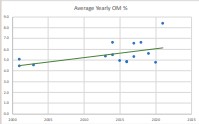
Nitrogen Use Efficiency and Organic
Matter
Having done 20 years of testing for organic matter in my soils I thought it would be a good idea to put all the results onto a spreadsheet and see what has happened over that time. I have a total of 63 tests, some fields have only been tested three or four times, others up to eight. The first thing that became obvious was the randomness of individual results in each field, organic matter percentages appear to fluctuate up and down over quite a wide range. This just shows the inaccuracies involved when sampling and testing in the lab. It is highly unlikely that a few grams of soil will ever be representative of the thousands of tonnes of soil in a whole field with variable soil type, however many sub samples are taken. By putting all the results onto one spreadsheet and then allowing the wonders of Excel Graphs to do its thing, the trend line is showing a definite increase over time. It would appear that on average over the last twenty years, my organic matter percentages have gone from 4.4 up to over 6. You can see on the graph that each dot represents an average of all the tests done in each respective year.

I have also taken quite a few samples in the last five years from different depths down to 45 cm. There is a gradual reduction of organic matter percentages as you go down, but even at the deepest depths, they are still around 4%. I didn’t do these deeper tests twenty years ago for comparison, but I believe it is fair to assume that organic matter is forming throughout the soil profile, albeit at a slower rate than near the surface. Having considered the weight of soil per hectare, soil bulk density and the fact that organic matter is fifty percent carbon, it appears that I am sequestering just over one tonne of carbon per hectare. The carbon to nitrogen ratio of organic matter is 10:1, which means that I am sequestering 100 kgs of nitrogen per hectare.
This is nitrogen that would otherwise be available to our crops. Most nitrogen requirement calculations assume ten to twenty kilograms is available from soil mineralisation, but regenerative farmers who are increasing their organic matter are immobilising 100 kgs per hectare. The nitrogen entering the system from fertiliser and fixation from the air is effectively being used to grow two crops, the above ground cash crop and the below ground organic matter accumulation. If both these are taken into consideration, I wouldn’t be surprised if my Nitrogen Use Efficiency is above 100%. In other words, fertiliser applications are not being lost to the atmosphere or leached into the drainage water but sequestered into soil organic matter along with the carbon.
My Wheat Blend
Blending cereal varieties is not a new idea, so after listening to talks by Prof Martin Wolfe and Prof Adrien Newton, in 2014 I decided to give it a try with some Hard Feed Wheats. With the help of my agronomist, four varieties that came from completely different breeding lines were used. This was surprisingly difficult because a high proportion of modern wheats are derived from Robigus. In my own trials Conqueror had always out yielded anything else. It is quite tall and has a slightly different growth habit to most varieties, and seems to particularly like my heavy land, no-till, low input system. The other three were JB Diego, Panorama and KWS Gator, and all four have maturity dates within three or four days.
The main reason for growing blends is disease prevention, blending slows down air borne diseases being passed from one plant to the next. There is plenty of trials work to prove this, but I have also seen evidence that even Septoria is reduced in a blend compared to a straight variety. It is very difficult to prove that my blend carried less disease, but from the beginning there didn’t seem to be any yield loss so I thought that it was worth continuing with, saving and re-drilling seed every year. I did trials in 2017, 2018 and 2019 comparing up to ten varieties and every time the blend came out as the highest yielding; so it now seems that there is no reason to even look at new varieties on the Recommended Lists and I now just re-drill the blend over all my wheat acreage.
I have had several DNA tests done and the seed for sowing this year came back with very different variety ratios compared to the original 25% of each. There is now only 5% of KWS Gator in the mix, with Panorama 10%, JB Diego 22% and the Conqueror has gone up to 63%. This confirms what a great variety Conqueror is for me because it is out yielding the others every year and is gradually taking over the blend. I now have a dilemma, do I allow the Conqueror to continue its domination, increasing the yield potential each year; or do I add one or two new varieties to bring back the diversity that was originally intended?
I am often asked about how I pay royalties, originally, I just paid 25% of my wheat acreage for each one. After a few years the BSPB insisted that they do a DNA test to find out what I was actually growing. I was expecting that there would have been some natural crossing with different varieties living so close together and that they would no longer attract the royalties, but it turns out that all four have maintained their purity. This is quite interesting because it is generally assumed that farmers who home save need to regularly buy in new first-generation seed. Seed merchants have always claimed that by continuously re-seeding, varieties would somehow deteriorate, or lose purity. This is clearly not the case and farmers should never feel the need to renew a variety once they have bought their first batch.